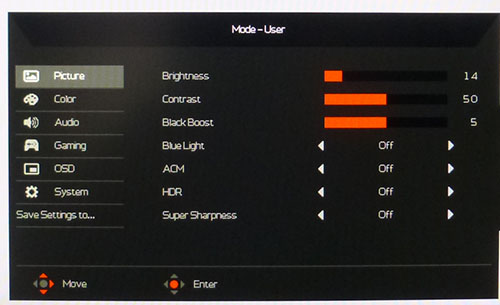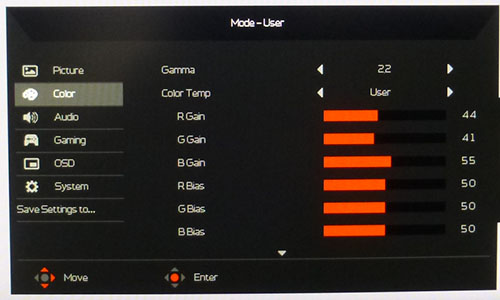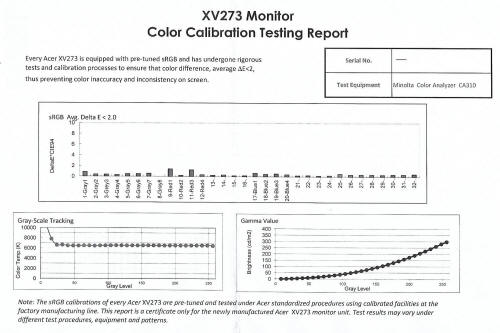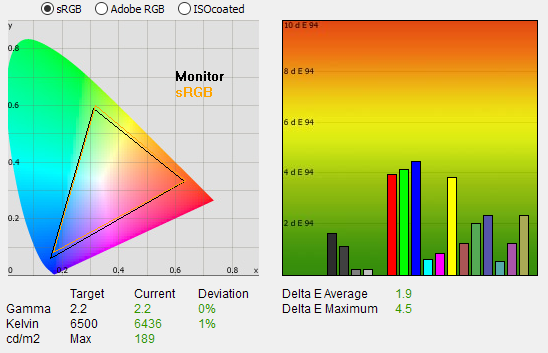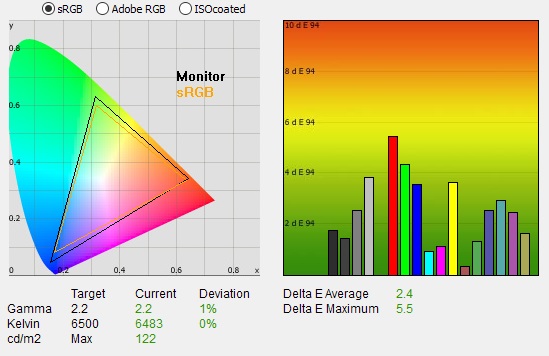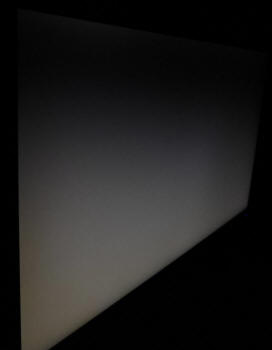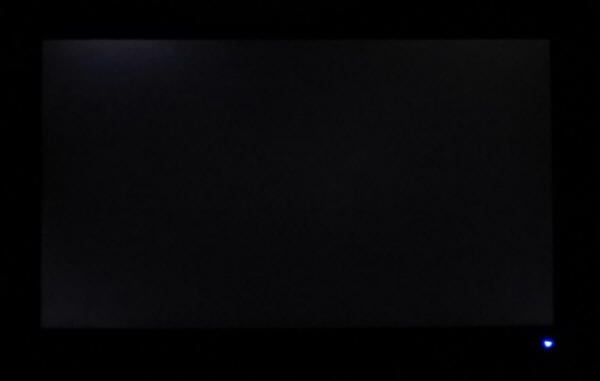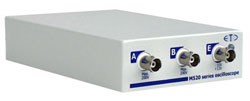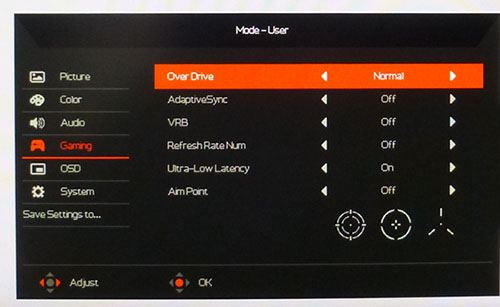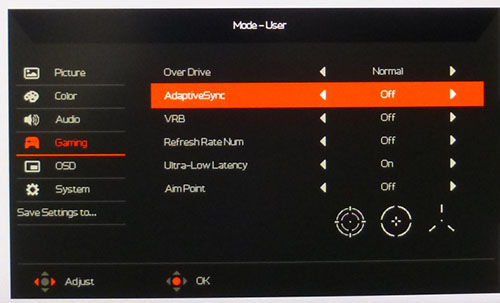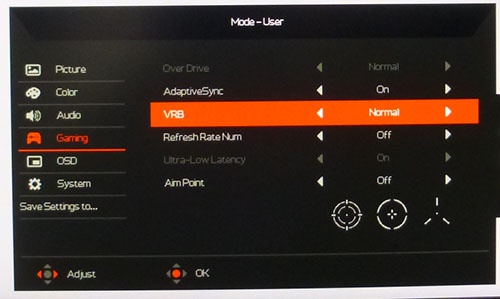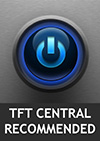|
|
||||
|
||||
|
|
|
||||||||||||||||||||||||||||||||||||||||||||||||||||||||||||||||||||||||||||||||||||||||||||||||||||||||||||||||||||||||||||||||||||||||||||||||||||||||||||||||||||||||||||||||||||||||||||||||||||||||||||||||||||||||||||||||||||||||||||||||||||||||||||||||||||||||||||||||||||||||||||||||||||||||||||||||||||||||||||||||||||||||||||||||||||||||||||||||||||||||||||||||||||||||||||||||||||||||||||||||||||||||||||||||||||||||||||||||||||||||||||||||||||||||||||||||||||||||||||||||||||||||||||||||||||||||||||||||||||||||||||||||||||||||||||||||||||||||||||||||||||||||||||||||||||||||||||||||||||||||||||||||||||||||||||||||||||||||||||||||||||||||
|
Monitor Specifications |
|||
|
Size |
27" |
Panel Coating |
Light AG coating |
|
Aspect Ratio |
16:9 flat |
Interfaces |
1x DisplayPort 1.2
2x HDMI 2.0 |
|
Resolution |
1920 x 1080 |
||
|
Pixel Pitch |
0.311mm |
Design colour |
Matte black bezels and arm with some red trim. Silver aluminium stand foot |
|
Response Time |
1ms G2G (0.1ms G2G min) |
Ergonomics |
Tilt, 115mm height, swivel, rotate |
|
Static Contrast Ratio |
1000:1 |
||
|
Dynamic Contrast Ratio |
100 million:1 |
VESA Compatible |
Yes 100 x 100 mm |
|
Brightness |
350 cd/m2 |
Accessories |
DisplayPort, HDMI and power cables. Factory calibration report |
|
Viewing Angles |
178 / 178 |
||
|
Panel Technology |
AU Optronics AHVA (IPS-type) |
Weight |
with stand: 6.24 Kg |
|
Backlight Technology |
W-LED |
Physical Dimensions (WxHxD) |
614 x 415-530 x 236 mm |
|
Colour Depth |
16.7m (8-bit) |
||
|
Refresh Rate |
240Hz |
Special Features |
AMD FreeSync, G-sync Compatible certified, 2x 2W speakers, VRB motion blur reduction mode, factory calibration |
|
Colour Gamut |
Standard sRGB gamut 99% |
||
The XV273 X offers a reasonable range of modern connectivity with 1x DisplayPort 1.2 and 2 x HDMI 2.0 offered for video connections. These are located on the back of the screen along with 2x downstream USB 3 ports and an audio output. There are then a further 2x USB ports located on the left hand edge of the screen for easy access. For PC connectivity the DisplayPort is the most common option, with HDMI being available then for connecting external games consoles or Blu-ray players potentially. HDMI supports VRR for games consoles while the DP connection should be used for PC systems, whether that's an AMD or NVIDIA graphics card. The screen has an internal power supply and comes packaged with the power cable that you need.
Below is a summary of the features and connections of the screen.
|
Feature |
Yes / No |
Feature |
Yes / No |
|
Tilt adjust |
|
DVI |
|
|
Height adjust |
|
HDMI |
|
|
Swivel adjust |
|
USB type-C |
|
|
Rotate adjust |
|
DisplayPort |
|
|
VESA compliant |
|
Component |
|
|
USB 2.0 Ports |
|
Audio connection |
|
|
USB 3.0 Ports |
|
HDCP Support |
|
|
Card Reader |
|
Integrated Speakers |
|
|
Ambient Light Sensor |
|
PiP / PbP |
|
|
Human Motion Sensor |
|
Blur Reduction Mode |
|
|
Touch Screen |
|
NVIDIA G-Sync (native) |
|
|
Factory calibration |
|
AMD FreeSync |
|
|
Hardware calibration |
|
G-sync Compatible Certified |
|
|
Uniformity correction |
|
Meaningful HDR |
|

Design and
Ergonomics

Above: front view of the screen
The XV273 X comes in a mostly black design, with matte plastics used for the bezel and rear enclosure. There is a silver 'acer' logo in the middle of the bottom bezel, and a removable NVIDIA G-sync and "colour accuracy" sticker on the bottom left hand corner. There is a 3-side borderless design on this screen with a thin 2mm plastic edge along the sides and top. There is also a black inner panel border which measures 6mm but the total edge to the screen is only 8mm so it looks very thin. The bottom of the screen has a thicker 21mm plastic bezel, There is a small blue power LED located in the bottom right hand corner which changes to amber when the screen is in standby mode.

Above: rear view of the screen
The back of the screen is encased in a matte black plastic for a simple design. The stand attaches via a quick release mechanism, and behind that there are also VESA 100mm mounting holes if you'd rather. The arm for the stand is also a matte black plastic with a cable tidy hole in the back. There is a small section of red plastic trim around the base of the arm at the front as you can see from the first photo. The base of the stand is a matte silver aluminium 3-pronged design. This provides a strong and sturdy base for the screen and is also not too deep. The OSD controls are located on the back left hand edge (when viewed from behind) as you can see above. There is a joystick control which makes navigation quick and easy.

Above: side
view of the screen
The stand offers a good range of ergonomic adjustments. Tilt provides a wide range of adjustment and is smooth and easy to operate. Height is also smooth but a little stiff, and provides a wide adjustment range as well. At the lowest setting the bottom edge of the screen is 50mm from the desk, and at maximum extension it's 170mm. This provides a decent 120mm adjustment range for the height adjustment. Side to side swivel is smooth and easy to move, and a rotation function is available, although a little stiff to operate. The screen remains very stable when you are moving it around thanks to the solid and sturdy base.
A summary of the ergonomic adjustments are shown below:
|
Function |
Range |
Smoothness |
Ease of Use |
|
Tilt |
Yes |
Smooth |
Easy |
|
Height |
120mm |
Smooth |
A little stiff |
|
Swivel |
Yes |
Smooth |
Easy |
|
Rotate |
Yes |
Fairly smooth |
A little stiff |
|
Overall |
Very good range of adjustments and all pretty easy and smooth to move. Screen remains very stable |
||
The materials were of a reasonable standard and the build quality felt decent enough. There was no audible noise from the screen, even when conducting specific tests which can often identify buzzing issues. The whole screen remained cool even during prolonged use.
The OSD is controlled through a series of 3 pressable buttons and a joystick control located on the back right hand side of the screen (when using it from the front). There is quick launch access to the preset mode menu, input selection, and brightness control. These can be customised in the menu too if you want. The main OSD menu is split in to 6 sections down the left hand side, with available options shown on the right. There are a wide range of settings to play with and configure and navigation was fast, intuitive and simple thanks to the joystick controller.

Power Consumption
|
|
|
We have plotted these results below compared with other screens we have tested. The consumption (comparing the calibrated states) is comparable to most of the other 27" sized screens we've tested as you might expect. The larger screens tend to have additional power usage as you might expect.


Panel and Backlighting
|
|
|||||||||||||||||||||||||||||
Panel Part and Colour Depth
The XV273 X features an
AU Optronics M270HAN03.0 AHVA (IPS-type) technology panel. This is a new
240Hz native IPS-type panel and the first time we've tested a screen featuring
it. The panel offers 16.7 million colours using
an 8-bit colour depth.
Screen
Coating
The screen coating is a light anti-glare (AG) offering. It isn't a semi-glossy coating, like some older generation VA panels and is similar to other recent IPS screens we've tested. Thankfully it isn't a heavily grainy coating like some much older IPS panels feature, and is also lighter than modern TN Film panel coating. It retains its anti-glare properties to avoid too many unwanted reflections of a full glossy coating, but does not produce too grainy or dirty an image that some thicker AG coatings can.
Backlight Type and Colour Gamut
The screen uses a W-LED backlight unit which is standard in today's market. This helps reduce power consumption compared with older CCFL backlight units and brings about some environmental benefits as well. The LED unit here offers a standard colour gamut which very closely matches the sRGB reference. If you want to read more about colour spaces and gamut then please have a read of our detailed article.
We verified that the backlight is dimmed using a direct current (DC) method as opposed to PWM, and so is flicker free as advertised. The oscillograph at our calibrated settings is included below for reference. Note: should a screen ever show PWM behaviour we would include more detailed analysis in this section.
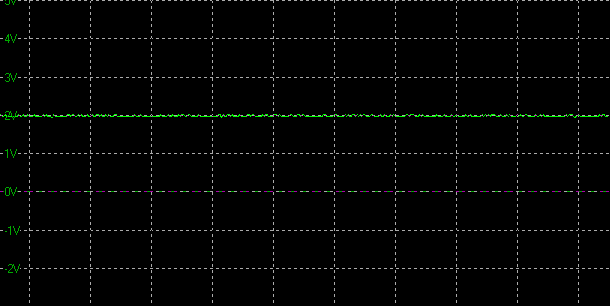
Above:
backlight operation showing constant Direct Current voltage instead of PWM.
Measured at calibrated brightness level

Brightness
and Contrast
This section tests the full range of luminance (the brightness of the screen) possible from the backlight, while changing the monitors brightness setting in the OSD menu. This allows us to measure the maximum and minimum adjustment ranges, as well as identify the recommended setting to reach a target of 120 cd/m2 for comfortable day to day use in normal lighting conditions. Some users have specific requirements for a very bright display, while others like a much darker display for night time viewing or in low ambient light conditions. At each brightness level we also measure the contrast ratio produced by the screen when comparing a small white sample vs. a black sample (not unrealistic full screen white vs. full screen black tests). The contrast ratio should remain stable across the adjustment range so we also check that.
Graphics card settings were left at default with no ICC profile or calibration active. Tests were made using an X-rite i1 Display Pro Plus colorimeter. It should be noted that we used the BasICColor calibration software here to record these measurements, and so luminance at default settings may vary a little from the LaCie Blue Eye Pro report you will see in other sections of the review.
|
OSD Brightness |
Luminance |
Black Point (cd/m2) |
Contrast Ratio |
|
100 |
461.76 |
0.39 |
1184 |
|
90 |
430.45 |
0.37 |
1163 |
|
80 |
393.52 |
0.34 |
1157 |
|
70 |
361.60 |
0.31 |
1166 |
|
60 |
322.72 |
0.27 |
1195 |
|
50 |
289.17 |
0.25 |
1157 |
|
40 |
248.78 |
0.21 |
1185 |
|
30 |
213.46 |
0.18 |
1186 |
|
20 |
171.20 |
0.15 |
1141 |
|
10 |
133.99 |
0.11 |
1218 |
|
0 |
89.55 |
0.08 |
1119 |
|
Total Luminance Adjustment Range (cd/m2) |
372.21 |
Brightness OSD setting controls backlight |
|
|
Total Black Point Adjustment Range (cd/m2) |
0.31 |
||
|
Average Static Contrast Ratio |
1170:1 |
PWM Free |
|
|
Recommended OSD setting for 120 cd/m2 |
8 |
At the full brightness setting in the OSD the maximum luminance reached a very high 462 cd/m2 which was a fair bit higher even than the 400 peak brightness spec from the manufacturer. There was a pretty decent 372 cd/m2 adjustment range in total, so at the minimum setting you could reach down to a luminance of 90 cd/m2. This doesn't afford you a super-low luminance option for working in darkened room conditions with low ambient light however so be a little wary if that is a specific requirement for you. A setting of 8 in the OSD menu should return you a luminance of around 120 cd/m2 at default settings. A little higher once you've been through calibration later on. It should be noted that the brightness regulation is controlled without the need for Pulse Width Modulation for all brightness settings so the screen is flicker free.
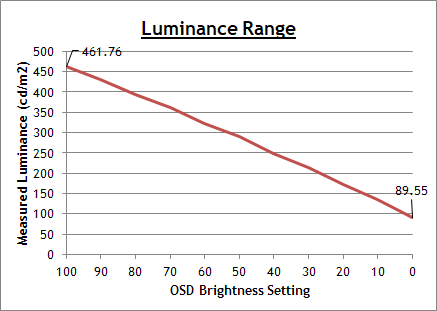

We have plotted the luminance trend on the graph above. The screen behaves as it should in this regard, with a reduction in the luminance output of the screen controlled by the reduction in the OSD brightness setting. This is a linear relationship.
The average contrast ratio of the screen was measured at 1170:1 out of the box which was strong for an IPS-type panel. It remained pretty stable across the brightness adjustment range as you can see above.
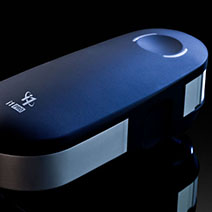
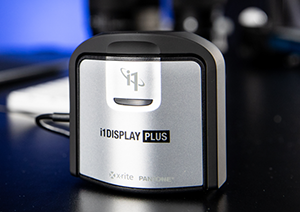
An important thing to consider for most users is how a screen will perform out of the box and with some basic manual adjustments. Since most users won't have access to hardware colorimeter tools, it is important to understand how the screen is going to perform in terms of colour accuracy for the average user.
We restored our graphics card to default settings and disabled any previously active ICC profiles and gamma corrections. The screen was tested at default factory settings using our new X-rite i1 Pro 2 Spectrophotometer combined with LaCie's Blue Eye Pro software suite. An X-rite i1 Display Pro Plus colorimeter was also used to verify the black point and contrast ratio since the i1 Pro 2 spectrophotometer is less reliable at the darker end.
Targets for these tests are as follows:
-
CIE Diagram - confirms the colour space covered by the monitors backlighting in a 2D view, with the black triangle representing the displays gamut, and other reference colour spaces shown for comparison. Usually shown as a comparison against the common sRGB space
-
Colour space coverage volumes - we also measure using a piece of software called ChromaPure the colour space (gamut) volumes produced by the backlight in comparison to the sRGB, DCI-P3 and Rec.2020 colour spaces. sRGB is the most commonly used colour space so it is important to have a decent coverage from the screen here. If the colour space is >100% sRGB then the screen can produce a wider colour gamut, often reaching further in to the wider gamut DCI-P3 (commonly used for HDR) and Rec.2020 reference spaces.
-
Gamma - we aim for 2.2 which is the default for computer monitors
-
Colour temperature / white point - we aim for 6500k which is the temperature of daylight
-
Luminance - we aim for 120 cd/m2, which is the recommended luminance for LCD monitors in normal lighting conditions
-
Black depth - we aim for as low as possible to maximise shadow detail and to offer us the best contrast ratio
-
Contrast ratio (static) - we aim for as high as possible. Any dynamic contrast ratio controls are turned off here if present
-
dE average / maximum - we aim for as low as possible. If DeltaE >3, the color displayed is significantly different from the theoretical one, meaning that the difference will be perceptible to the viewer. If DeltaE <2, LaCie considers the calibration a success; there remains a slight difference, but it is barely undetectable. If DeltaE < 1, the color fidelity is excellent.

Default Performance
and Setup
Default settings of the screen were as follows:
|
Acer
Nitro XV273 X
|
|
|||||||||||||||||||||||||||||
|
|
Initially out of the box the screen was set in the 'Standard' preset mode. Any changes to any setting move you out of that mode and to the 'user' profile instead. The display was set with a very bright 70% brightness which was uncomfortable to use for long periods. You will want to turn that down as with most screens. The colour balance felt fairly good, maybe a little warm which was probably not surprising as the default color temp mode was set to 'warm'. We went ahead and measured the default state with the i1 Pro 2. The CIE diagram on the left of the image confirms that the monitors colour gamut (black triangle) extends a little bit beyond the sRGB reference space (orange triangle), mostly in green and blue shades but not by anything significant. We measured using ChromaPure software a 109.0% sRGB gamut volume coverage which corresponds to 80.6% of the DCI-P3 reference and 57.9% of the Rec.2020 reference. This is basically a standard sRGB gamut screen with some minor over-coverage. This shouldn't represent any real issue in practice. Default gamma was recorded at 2.2 average with a minor 2% deviance from the target which was pleasing. There are three gamma modes in the menu which we measured for completeness. Each mode produced the desired average gamma of 1.8, 2.2 or 2.4. This gives you some flexibility if you want something different perhaps for gaming. |
|
White point was measured at 6046k, being a little too warm (7% deviance) which is good news in the 'warm' mode. We did also measure the other modes and found that the 'normal' mode was closest to our 6500k target, measured at 6593k out of the box. The 'cool' mode was 7915k while the 'Blue Light' mode (for reduced blue light that is) was 5151k. There is also a 'User' mode available in the menu where you have access to the RGB channels which will be useful for calibration shortly which by default is set the same as the 'warm' mode.
Luminance at the default 70% brightness level
was recorded at a very bright 376
cd/m2
which is too high for prolonged general use, you will need to turn that down.
The black depth was 0.32 cd/m2
at this default brightness setting, giving us a strong static contrast ratio for
an IPS-type panel of
1166:1. Colour accuracy measurements
showed an average dE of 1.9, maximum of 4.6 which was pretty decent. When
testing the screen with colour gradients there were very smooth transitions and
no sign of any banding.
The screen comes with a factory calibration report in the box which confirms Acer have set up the screen to meet certain standards. A sample of the report which came with our unit is included below. The screen has an sRGB mode available in the OSD menu which is supposed to carry this factory calibration. When you enable that sRGB option it defaults a lot of the controls to certain values. If you then change any of those settings it moves you out of the sRGB mode and in to the 'user' mode, so this is basically a pre-defined mode with locked settings.
|
Acer
Nitro XV273 X
|
|
|||||||||||||||||||||||||||||
|
This sRGB factory calibrated mode actually offered a slight reduction in the colour gamut of the screen, helping to cut down on some of the minor over-coverage, most noticeably in the green shades. We measured now a 95.7% sRGB coverage compared with the native 109.4%. Now a little too low in fact.
This sRGB mode also offered a minor improvement to the gamma, removing the small 2% deviance we'd seen at default settings. The white point was also now corrected to 6436k, being much closer to the target 6500k than the 7% deviance we'd seen before. The brightness control was reduced in this mode from 70 down to 30 so it was far more comfortable, although still a little bright. The colour accuracy remained largely the same as before, so really this mode was mostly useful to fine tune the gamma and white point.
![]()
Optimal Settings
Pre-Calibration
In a new section we hope to include in future
reviews we also measured the screen after adjusting only the OSD controls, to
obtain the optimal setup without a full calibration, and without the use of an
ICC correction profile. This represents what could be achieved through just
simple changes to the monitor itself, and also what you could expect when
working with content outside of an ICC profile managed workflow. The early
stages of our calibration software helped identity these optimal OSD settings.
|
Acer
Nitro XV273 X
|
|
|||||||||||||||||||||||||||||
|
This has helped correct the white point to approximately 6500k and reduce the brightness to a more comfortable level. The contrast ratio as dropped a little to correct that white point, but still remains strong for an IPS-type panel. Further calibration and profiling below will help improve things even further.
We used the X-rite i1 Pro 2 Spectrophotometer combined with the LaCie Blue Eye Pro software package to achieve these results and reports. An X-rite i1 Display Pro Plus colorimeter was used to validate the black depth and contrast ratios due to lower end limitations of the i1 Pro device.
|
Acer
Nitro XV273 X
|
|
|||||||||||||||||||||||||||||
|
The OSD settings were adjusted as shown in the table above, as guided during the calibration process and measurements. These OSD changes allowed us to obtain an optimal hardware starting point and setup before software level changes would be made at the graphics card level. We left the LaCie software to calibrate to "max" brightness which would just retain the luminance of whatever brightness we'd set the screen to, and would not in any way try and alter the luminance at the graphics card level, which can reduce contrast ratio. These adjustments before profiling the screen would help preserve tonal values and limit banding issues. After this we let the software carry out the LUT adjustments and create an ICC profile.
The accurate default gamma of 2.2 was maintained here and it corrected the minor 2% deviance, while the white point was also now corrected to 6533k which was great news. The brightness control adjustment had reduced the luminance to a comfortable level now, and the screen maintained a strong static contrast ratio of 1036:1 for an IPS-type panel. Colour accuracy of the resulting profile was excellent, with dE average of 0.3 and maximum of 1.0. LaCie would consider colour fidelity to be very good overall. Gradients remained smooth and free from banding.
You can use our settings and try our calibrated ICC profile if you wish, which are available in our ICC profile database. Keep in mind that results will vary from one screen to another and from one computer / graphics card to another.

Setup Comparisons
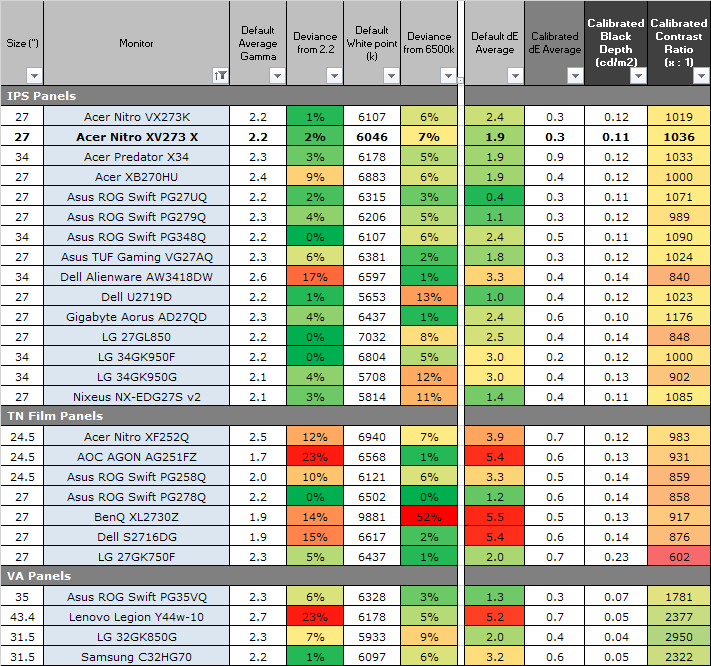
The comparisons made in this section try to give you a better view of how each screen performs, particularly out of the box which is what is going to matter to most consumers. We have divided the table up by panel technology as well to make it easier to compare similar models. When comparing the default factory settings for each monitor it is important to take into account several measurement areas - gamma, white point and colour accuracy. There's no point having a low dE colour accuracy figure if the gamma curve is way off for instance. A good factory calibration requires all 3 to be well set up. We have deliberately not included luminance in this comparison since this is normally far too high by default on every screen. However, that is very easily controlled through the brightness setting (on most screens) and should not impact the other areas being measured anyway. It is easy enough to obtain a suitable luminance for your working conditions and individual preferences, but a reliable factory setup in gamma, white point and colour accuracy is important and some (gamma especially) are not as easy to change accurately without a calibration tool.
From these comparisons we can also compare the calibrated colour accuracy, black depth and contrast ratio. After a calibration the gamma, white point and luminance should all be at their desired targets.
Default setup of the screen out of the box
was pretty decent overall. There was a reliable gamma which was great news as
this is often the hardest thing to correct without a calibration device. There
was a strong default contrast ratio for an IPS panel, and a reasonably low dE
average. White point was a little too warm, but easy to correct using the
provided colour temp preset modes, or through simple RGB control changes.
Overall a decent performance considering it's a gaming screen and these are
often set up with much less accurate options. If you look at the other 240Hz
screens we've tested (all TN Film models), they had a less accurate setup,
especially when it came to gamma out of the box - the
Acer Nitro XF252Q,
AOC AGON AG251FZ and
Asus ROG Swift PG25Q. The additional attention to a more accurate setup, and
even a factory calibration from Acer was welcome here.
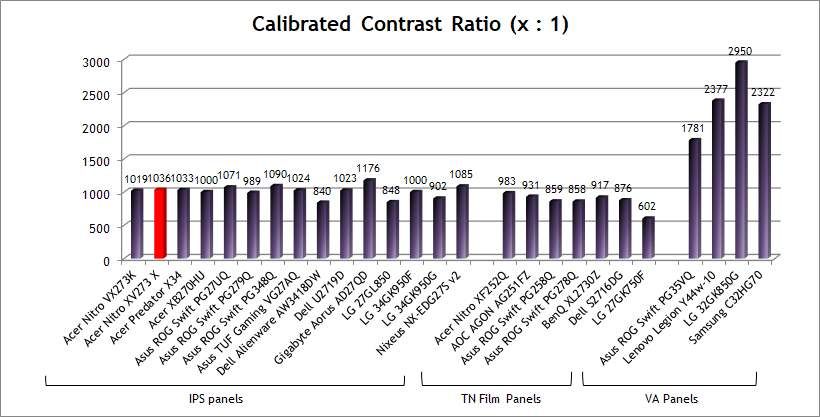
The contrast ratio was strong for an IPS panel and was measured at 1036:1 after calibration. This was higher than some other IPS panels which ranged down to around 850 - 900:1, but of course can't live up to the much higher contrast ratios of VA-type panels which are more like 2000 - 3000:1 commonly.
|
Check Pricing and Buy - Direct Links |
|
TFTCentral is a participant in the Amazon Services LLC Associates Programme, an affiliate advertising programme designed to provide a means for sites to earn advertising fees by advertising and linking to Amazon.com, Amazon.co.uk, Amazon.de, Amazon.ca and other Amazon stores worldwide. We also participate in a similar scheme for Overclockers.co.uk. |

Viewing Angles

Above: Viewing angles shown from front and side, and from above and below.
Click for larger version
Viewing angles of the screen were very good as you would expect from an IPS-type panel. Horizontally there was very little colour tone shift until wide angles past about 45°. A slight darkening of the image occurred horizontally from wider angles as you can see above as the contrast shifted slighting. Contrast shifts were slightly more noticeable in the vertical field but overall they were very good. The screen offered the wide viewing angles of IPS technology and was free from the restrictive fields of view of TN Film panels, especially in the vertical plane. It was also free of the off-centre contrast shift you see from VA panels and a lot of the quite obvious gamma and colour tone shift you see from some of the modern VA panel type offerings.
Above: View
of an all black screen from the sides. Click for larger version
On a black image there is a characteristic pale glow introduced to the image when viewed from a wide angle, commonly referred to as IPS glow. This type of glow is common on most modern IPS-type panels and can be distracting to some users. If you view dark content from a normal head-on viewing position, you may see this glow as your eyes look towards the edges of the screen. The level of glow on this panel was comparable to other high refresh rate AUO IPS panels we've tested in the past such as the Asus ROG Swift PG279Q and Asus TUF Gaming VG27AQ for instance.
This type of glow is common on most modern IPS-type panels and can be distracting to some users. If you view dark content from a normal head-on viewing position, you may see this glow as your eyes look towards the edges of the screen depending on your viewing position. It will also be more noticeable in darker ambient light conditions and if you're viewing a lot of dark content. Some people may find this problematic if they are playing a lot of darker games or watching darker movies. In normal day to day uses you couldn't really notice this unless you were viewing darker content. If you move your viewing position back, which is probably likely for movies and games keep in mind, the effect reduces as you do not have such an extreme angle from your eye position to the screen edges.

Panel Uniformity
We wanted to test here how uniform the brightness was across the screen, as well as identify any leakage from the backlight in dark lighting conditions. Measurements of the luminance were taken at 35 points across the panel on a pure white background. The measurements for luminance were taken using BasICColor's calibration software package, combined with an X-rite i1 Display Pro colorimeter with a central point on the screen calibrated to 120 cd/m2. The below uniformity diagram shows the difference, as a percentage, between the measurement recorded at each point on the screen, as compared with the central reference point.
It is worth noting that panel uniformity can vary from one screen to another, and can depend on manufacturing lines, screen transport and other local factors. This is only a guide of the uniformity of the sample screen we have for review.
![]()
Uniformity of Luminance
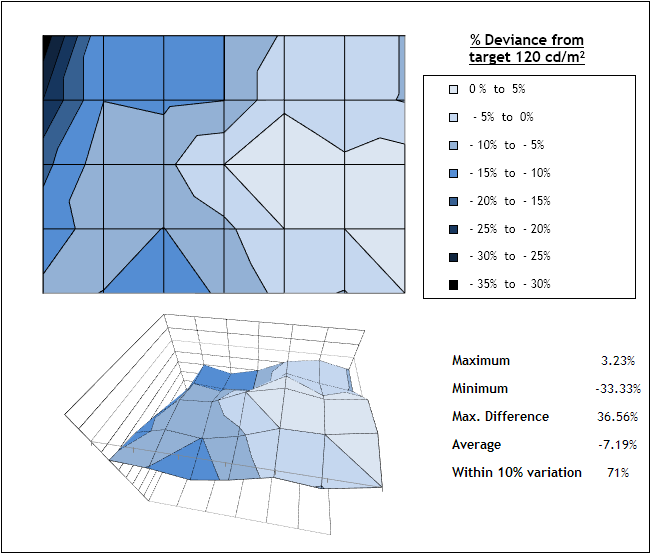
Luminance uniformity of the screen was fairly good on our sample, with 71% of the screen within a 10% deviance of the centrally calibrated area. Along the left hand edge and upper left region the screen was a little darker and there was a modest drop in luminance down to 90 cd/m2 in the most extreme case (-33%), in the top left corner.
![]()
Backlight Leakage
Above: All
black screen in a darkened room. Click for larger version
We also tested the screen with an all black image and in a darkened room. A camera was used to capture the result. There was some slight clouding and leakage from the corners, most notably in the top left corner. This was very hard to see during normal usage though.
Note: if you want to test your own screen for backlight bleed and uniformity problems at any point you need to ensure you have suitable testing conditions. Set the monitor to a sensible day to day brightness level, preferably as close to 120 cd/m2 as you can get it (our tests are once the screen is calibrated to this luminance). Don't just take a photo at the default brightness which is almost always far too high and not a realistic usage condition. You need to take the photo from about 1.5 - 2m back to avoid capturing viewing angle characteristics, especially on IPS-type panels where off-angle glow can come in to play easily. Photos should be taken in a darkened room at a shutter speed which captures what you see reliably and doesn't over-expose the image. A shutter speed of 1/8 second will probably be suitable for this.

General and Office Applications
With a 1920 x 1080 resolution, the desktop real estate of the VX273 X feels a pretty big step down compared with all the high resolution panels we've tested, and the 27" 2560 x 1440 models we are used to using day to day. You do lose a large amount of desktop space, and although side by side split screen working is possible, it's not as easy due to the more limited resolution and space. With a 0.311 mm pixel pitch, text is comfortable and easy to read natively, providing a still fairly sharp and crisp image. It is not as sharp as the 1440p panels we've become accustomed to, or of course any ultra HD/4K resolutions where scaling is used, but it is perfectly adequate. We would have preferred a full 1440p resolution on a 27" screen like this to be honest, although it is primarily aimed at gaming. With the high 240Hz refresh rate in mind, it's probably more realistic to be powering a 1920 x 1080 resolution than 2560 x 1440 anyway for those purposes. Not to mention the fact that this is the first and only 240Hz IPS panel and it is currently only available at 1080p maximum anyway. It's just a shame when it comes to more general office work that the resolution is pretty low.
The light AG coating of the IPS technology panel is certainly welcome, and much better than the older grainy and 'dirty' appearance of older IPS AG coatings. Although it's been several years since those more grainy coatings were used. The wide viewing angles provided by this panel technology on both horizontal and vertical planes, helps minimize on-screen colour shift when viewed from different angles.
The out of the box setup was good for these kind of uses, with a reliable gamma, pretty low dE and decent contrast ratio for an IPS panel. The white point needs some minor correction but that's easy to do. The brightness range of the screen was a bit limited for these kind of uses, with the ability to offer a luminance between 462 and 90 cd/m2. This might mean that you are more limited in darker room conditions and low ambient light and for lots of text and office work. Although getting down to 120 cd/m2 will still be adequate for many users. Again, this is a gaming screen and so most people will want the brighter settings for gaming, especially if you also want to use the VRB motion blur reduction mode which will impact brightness quite a lot. We would have just liked to see a lower minimum adjustment for office and general uses ideally.
A setting of 8 in the OSD brightness control should return you a luminance close to 120 cd/m2 out of the box. The brightness regulation is controlled via a flicker free backlight, without the need for Pulse Width Modulation (PWM), and so those who suffer from eye fatigue or headaches associated with flickering backlights need not worry. There was no audible noise from the screen, even when conducting specific tests which can sometimes cause issues.
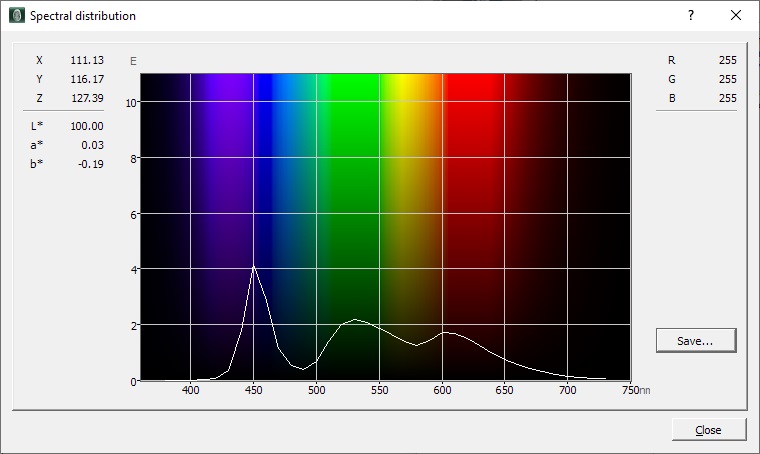
Spectral distribution graph
showing calibrated mode at 6500k
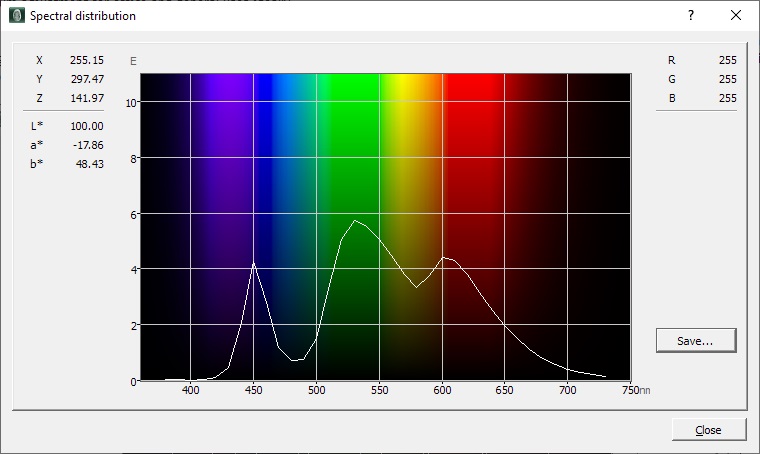
Spectral distribution graph
showing
Blue Light Filter mode set at
50%
There are modes provided for Blue Light filtering in the OSD although these are mostly not useable in practice sadly. You can see above a fairly typical backlight spectral output for the screen calibrated to 6500k where the blue light peak is particularly high. In the OSD menu there are two places where you can move to the blue light filter. The first is in the 'picture' section of the menu where there is a 'Blue Light' control, with settings for 80%, 70%, 60% and 50%. Each of these makes the image progressively warmer, reducing the blue light and making the image look a little more yellow/green each time. These modes unfortunately also carry a preset brightness level which is too high for actual day to day usage For instance the 50% blue light mode (spectral output shown above) is the warmest at 4617k measured, with the lowest blue light peak, but has a preset 60 brightness control! If you change the brightness manually, it turns the blue light mode off. This makes these modes unusable in practice unless you also want a particularly high luminance output to the screen.
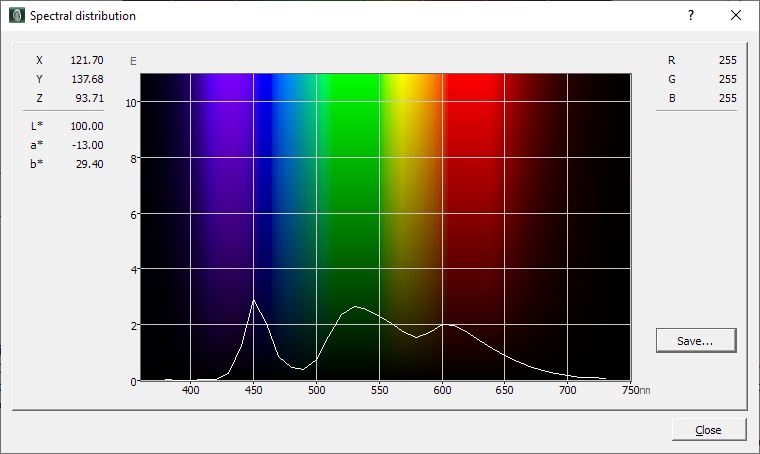
Spectral distribution graph
showing
Blue Light color temp mode set
There is thankfully one mode where you can use the blue light filter a little bit more easily and in a sensible brightness level. You have to set your screen brightness to how you want it, and then in the 'color' > 'color temp' option change the mode to 'blue light'. This turns the blue light control on to the 70% level, but does not impact your set brightness level. You cannot change to any of the other blue light levels without it then presetting the brightness again, but you can at least use the filter at 70% with your custom set brightness. This produced a colour temp of 5119k so is a fair bit warmer than our calibrated state, and helps reduce the blue light peak as you can see above.
There are 4x USB 3 ports provided on this screen, two on the back and two on the left hand edge of the screen for easy-access. There are also no other extras like ambient light sensors, motion sensors or card readers on this screen which are sometimes useful for office-type uses. There is a decent range of ergonomic adjustments from the stand with tilt, height, swivel and rotate offered. Height is a little stiff to operate but on the whole, moving the screen around is fine There is also VESA 100mm mounting capabilities for those who want to mount the screen instead.

Responsiveness and Gaming
|
Panel Manufacturer and Technology |
AU Optronics AHVA (IPS-type) |
|
Panel Part |
M270HAN03.0 |
|
Quoted G2G Response Time |
1ms G2G |
|
Quoted MPRT Response Time |
n/a |
|
Overdrive Used |
|
|
Overdrive Control Available Via OSD Setting |
Over Drive |
|
Overdrive OSD Settings |
Off, Normal, Extreme |
|
Maximum Refresh Rate |
240Hz |
|
Variable Refresh Rate technology |
AMD FreeSync |
|
Variable Refresh Rate Range |
48 - 240Hz |
|
Blur Reduction Backlight |
|
The screen uses overdrive technology to boost pixel transitions across grey to grey changes as with nearly all modern displays. The part being used is an AU Optronics M270HAN03.0 AHVA (IPS-type) technology panel. Have a read about response time in our specs section if you need additional information about this measurement.
We use an
ETC M526
oscilloscope for these measurements along with a custom photosensor device.
Have a read of
our response time measurement article for a full explanation of the testing
methodology and reported data.

Response Times and Refresh Rate
There's various things you need to consider when it comes to response times and gaming, particularly on a display with high refresh rate support. Gaming screens invariably give you a control for the overdrive impulse in the OSD menu which can help you tweak things, but response time performance and overshoot levels can vary depending on the active refresh rate. This behaviour is often different depending on whether the screen is a traditional G-sync screens (with hardware module) or whether it's an adaptive-sync screen as well, and not all screens behave in the same way. We always try to test each variable in our reviews but the key considerations you need to make are:
-
Performance at 60Hz - this is important if you want to use an external games console (or other device like a Blu-ray player etc) which typically run at 60Hz. Response time performance may well be different than at the higher refresh rates supported, and you may need a different overdrive setting for optimal experience.
-
Performance during VRR (Variable Refresh Rate) - bearing in mind that the refresh rate will fluctuate anywhere from 1Hz up to the maximum supported by the screen (e.g. 1 - 144Hz on a 144Hz display). It's important to understand if the response times and overshoot will vary as the refresh rate changes. There may be a need to switch between different overdrive settings in some cases, depending on your usually attained refresh rate output and graphics card capability. This can sometimes become fiddly if your refresh rates fluctuate a lot, especially between different games, so it's always easier if you can leave a display on a single overdrive setting which is suited to the whole range. Some screens also feature "variable overdrive" which helps control the response times and overshoot depending on the active refresh rate. This is particularly apparent with traditional G-sync module screens.
-
Performance at fixed refresh rates including maximum - this is important for those who have a powerful enough system to consistently output a frame rate to meet the max refresh rate capability of the screen. They may want to run at max refresh rate without VRR active, or even is VRR is active they may know they will be consistently at the upper end of the range. Many gaming screens show their optimal response time performance at the maximum refresh rate. Knowing the performance at high fixed refresh rates may also be applicable if you want to use any added blur reduction backlight which typically operate at a fixed refresh rate.
-
Whether the response times can keep up with the frame rate - you will also want to consider whether the response times of the panel can consistently keep up with the frame rate. For instance a 144Hz screen sends a new frame to the display every 6.94ms, so the pixel response times need to ideally be consistently and reliably under this threshold. If they are too slow, it can lead to added blurring in practice and sometimes make the higher refresh rates unusable in real life. We consider this in our analysis.
![]()
|
We carried out some initial response time measurements and visual tests in each of the overdrive settings, and at a range of refresh rates. The overdrive control is available in the OSD menu via the 'Over Drive' option as shown. There are 3 levels available - Off, Normal and Extreme.
|
|
240Hz Refresh Rate
We are going to start with 240Hz here which is the maximum refresh rate the screen can support to observe the behaviour of each of the Over Drive modes.



Even with overdrive set to 'off' the response times were not actually too bad for an IPS panel. We measured a 5.8ms G2G average with some reaching up a bit higher though in to the 7 - 10ms range. There was no overshoot at all though. Moving up to the 'normal' mode brought about some decent improvements in motion clarity and sharpness of a moving image. Response times had improved down to 4.7ms G2G average, and the slower 7 - 10ms transitions had been sped up very nicely now. There was still no overshoot which was great news. If you push all the way up to the maximum 'Extreme' mode, you get some further improvements in response time, but it comes at the cost of some high levels of overshoot that start to creep in. In practice you see some slight pale halos behind moving objects. They are quite slight because of the high refresh rate here, and they don't last for very long. The 'normal' mode still offered the optimal performance and looked the best to the naked eye.
Lowering
Refresh Rates (Normal Over Drive mode)





Having settled on the 'normal' Over Drive mode at 240Hz, we then took some measurements at different lower refresh rates as shown above. The response times were slightly faster it seems than at 240Hz, but not by anything significant. Overall the response times remained pretty consistent across the refresh rate levels at around 4.1 - 4.7ms G2G average. There was no variable overdrive being used here which is typical for FreeSync screens (unlike most Native G-sync screens), but at least the response times were consistently strong so it didn't matter really. As you reached down to the bottom end at 60Hz, some moderate levels of overshoot started to appear. So while the response times remained consistent across the refresh rate range from 60 - 240Hz in our tests, the overshoot did creep up a bit at the lower fresh rates. In practice you could see a bit of pale overshoot on moving content, but it wasn't too major. This was only really at the lowest refresh rates.
60Hz Refresh Rate


We also tested the 'Off' mode at 60Hz to see if that helped reduce the overshoot we'd seen before in the 'Normal' mode. It did indeed remove all the overshoot, and the overall response times didn't take too much of a hit, dropping from 4.2ms G2G average down to 5.2ms G2G which is still very strong for a 60Hz IPS panel. As an idea, a figure of around 8.5ms G2G has previously been the best we've seen from a 60Hz IPS panel without any overshoot, so there are decent improvements here on this display, even at 60Hz and even with Over Drive turned off. For external consoles and devices with a fixed 60Hz we would recommend the Off mode for optimal performance.

Variable Refresh Rates
(VRR)
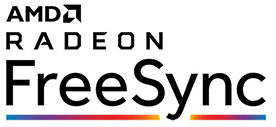
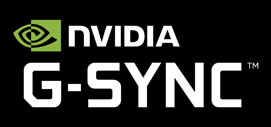
The screen natively supports AMD FreeSync for variable refresh rates between 48 and 240Hz. The screen is currently not certified under their newer FreeSync 2 scheme but it has been officially certified under NVIDIA's recent 'G-sync Compatible' scheme. This means you can use it from NVIDIA graphics cards with variable refresh rates with validated performance levels. The screen is co-branded with NVIDIA G-sync as well, with a sticker on the front bezel and a logo on the load up screen too. Clearly this is a big feature Acer want to promote.
You need to enable 'AdaptiveSync' from within the OSD menu as shown above if you want to use FreeSync or G-sync. When you do this, it actually greys out the Over Drive control and locks it at 'Normal'. This is thankfully the optimal mode for VRR anyway so is of no concern.
The support for FreeSync and G-sync will be very useful given the significant system demands of running a screen at 1920 x 1080 resolution and up to 240Hz refresh rate. It was of course very good to see it included here. We will discuss some of the considerations for using VRR in the following section when it comes to response time performance. You might also want to read our newly updated article about Variable Refresh Rates here.

Detailed Response Times
The response time performance of the XV273 X was thankfully quite simple, as you could comfortably stick with the Normal Over Drive mode we felt for all refresh rates, including when using VRR (FreeSync / G-sync) and even for fixed 60Hz input sources. There is a chance that you might see a bit of overshoot creeping in at lower refresh rates like 60Hz, so if that's an issue at all you can switch down to the 'Off' mode to eliminate that.
The higher refresh rates really help improve motion clarity and reduce perceived blur, making the screen far better for gaming than 60Hz-only models. There were also a reasonable improvement in perceived motion clarity we felt when switching between 144Hz and 240Hz modes which we will try to demonstrate a bit more in a moment. The support for VRR from both AMD and NVIDIA systems was welcome as ever, particularly useful given the high demands of this resolution and refresh rate combination.
Recommended Settings
|
Optimal Refresh Rate |
240Hz |
|
Optimal Overdrive Setting (for above) |
Normal |
|
Optimal Overdrive Setting for 60Hz |
Normal |
|
Optimal Overdrive Setting for VRR |
Normal |
Detailed Measurements at Optimal
240Hz, Over Drive Normal


We carried out some further response time
measurements at 240Hz. The screen performed really well for an IPS-type panel,
with an average G2G response time of 4.8ms G2G, all without any sign of
overshoot at all. Moving images looked sharp and clear and with a noticeable
improvement in overall motion clarity compared with lower refresh rates, even
144Hz which has become a very popular "high refresh rate" option. We were
impressed by the performance here.
![]()
Can IPS Keep up with the 240Hz Refresh Rate?
One area we want to talk about more is whether the response times can keep up with the refresh rate. If you look at the table above, you can see that only 36.7% of the pixel transitions were actually fast enough to keep up with 240Hz from a strict measurement point of view. For 240Hz you get a new frame every 4.17ms and so the pixel response times should ideally be consistently less than this to keep up. If they are not, it can lead to some additional added motion blur on moving content. If we allow for a bit of a wider refresh rate window with an additional +1ms room, then 60% of the measured transitions were within the window which was better (also included in the table above).
The pixel response times of the IPS panel were not quite fast enough to truly keep up with the 240Hz frame rate - but does it matter in practice? More on that in a moment. If you compare them with the response times of a modern TN Film panel like the Acer Nitro XF252Q for instance (0.5ms rated, latest generation of TN Film) you can see that the TN Film panel is faster. It has a 2.6ms G2G average (with low levels of overshoot) and although it's not listed in that review, 90% of the transitions were within the refresh rate window (96.7% if you allow additional 1ms room). So the TN Film panel can, probably unsurprisingly, keep up better with 240Hz on paper.
In practice does this matter? On the XV273 X it didn't seem to cause much of a negative impact to be honest. The response times were still very impressive, and although they can't quite keep up, they weren't far off. We carried out some visual tests at both 144Hz (where they were more than fast enough) and 240Hz to see how both looked as a direct comparison. We used the familiar tests at www.testufo.com to help demonstrate this.
At 240Hz you can see a little bit of added blur where the lines of the moving UFO look a little more blurry as they move across the screen. It's quite slight though, and hard to see much real difference compared with 144Hz in that regard. However, we did feel that overall the image looked clearer and sharper at 240Hz than it did at 144Hz and that is because of the increased frame /refresh rate. Refresh rate has a direct correlation to perceived motion blur on LCD displays and any slight additional blurring at 240Hz caused by the slightly-too-slow response times was easily offset by the improvements in perceived motion clarity brought about by the increased refresh rate.

We captured this as best we could with a pursuit camera setup, which is designed to captured motion blur as you would perceive it with the naked eye as you track a moving object across the screen. You can see that at 240Hz the overall clarity was improved and the image looked sharper. This was thanks to the higher refresh rate. This is a good demonstration of how 240Hz can bring about some improvements compared with common 120/144Hz refresh rate screens. You can see the small affect of the response times being not quite fast enough too, where the yellow part has a more blurred trail, as does the black edge of the red part of the image. That blurring, caused by the response times being slightly too slow for 240Hz, is very minimal in practice.
So overall, yes the XV273 X was perfectly
usable at 240Hz we felt and performed very well. This was all without any
overshoot as well which was very impressive. We were pleasantly surprised for an
IPS-type panel.
For reference, we know that response times remain largely consistent across the refresh rate range, so if we consider the measurements from the above table we can consider the compliance with the refresh rate at different settings.
Pixel response time compliance with
refresh rate

For refresh rates up to around 180Hz the
pixel response times were fast enough to keep up with the frame rate demands
with very few issues. Above that, you could see that they weren't quite keeping
up. You get a small amount of additional blurring to the image but with the
difference being very minimal, and the refresh rate benefits coming in to
effect, there was actually not any real issue here. As we've said above, the
screen is very useable at all the way up to 240Hz.
![]()
What about the advertised 0.1ms G2G min response time?
At the 'Normal' Over Drive setting the fastest response time we measured was 2.4ms G2G, and that's without any overshoot at all. That's very impressive for any panel technology, but where does the advertised 0.1ms G2G figure come from then?
We have seen other IPS panels advertised with 1ms G2G figures already, like the LG 27GL850. This seems to be "the new thing" and we've now got a race to the bottom it seems for the fastest advertised response times. 0.1ms G2G seems wholly unrealistic, especially for an IPS panel which has never been as fast as something like TN Film anyway. As we found out when we tested that LG screen, their advertised 1ms G2G was only achieved with the maximum overdrive setting and in the most unrealistic, and unusable circumstances. To achieve it resulted in huge levels of overshoot which were horrible in practice.
Detailed Measurements at
240Hz, Over Drive Extreme
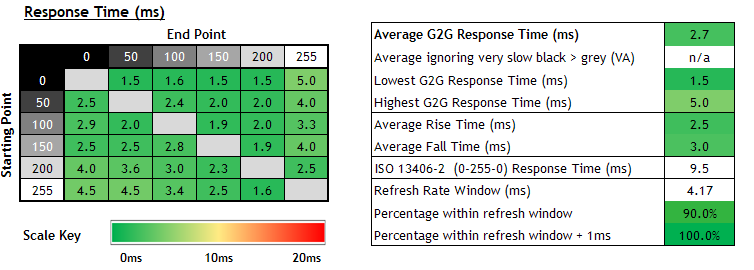
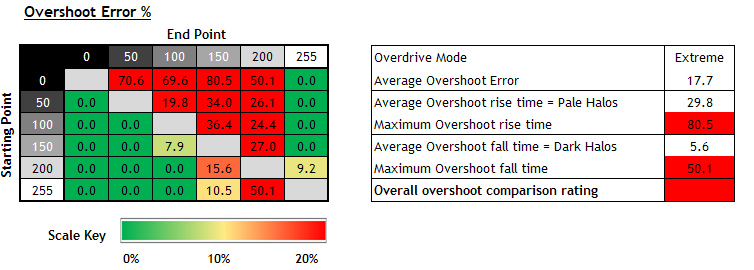
We carried out some measurements at the highest 'Extreme' overdrive setting to see if that made 0.1ms G2G (or even 1ms G2G for that matter!) possible, at least on paper. The lowest measurement we had here was 1.5ms. Impressive in itself for IPS technology but nowhere near 0.1ms. There were very high levels of overshoot in this mode though, particularly on the rise times which resulted in noticeable pale halos on moving objects. As the refresh rate lowers, the response times remain pretty consistent, but the overshoot increases even further. The 'Extreme' mode should be avoided.
So even in the fastest mode available 0.1ms was unachievable. This is not surprising really, but we would much rather manufacturers stuck to realistic and achievable specs instead of racing to offer the most aggressive number on paper. In fact the advertised 1ms G2G spec is only just about achievable in this Extreme mode, but again is totally impractical to use in real life. A sensible spec for this screen would have been 4 - 5ms G2G which is fast still for an IPS panel and actually realistic at the optimal and useable settings.
![]()
Motion Blur Reduction
(VRB mode)
The strobing blur reduction backlight option is available via the 'Visual Response Boost' (VRB) setting. This cannot be used at the same time as adaptive sync, so if you enabled VRB, it will disable FreeSync/G-sync support. The Over Drive control is still available to select, but the 'normal' mode remains optimal as before.
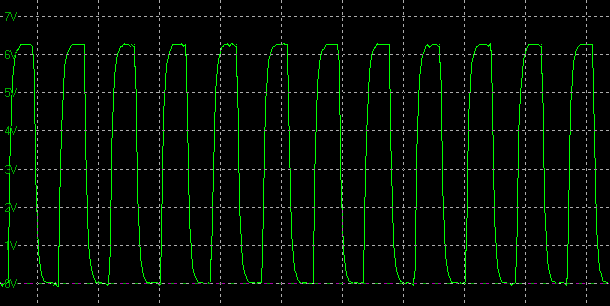
Normal mode - Example strobing at 240Hz, horizontal scale = 5ms
This option is available by default at refresh rates of 120, 144 and 240Hz only. We did find that we could create custom resolutions with a refresh rate of 100, 85 and 75Hz and that the VRB mode would also run at those refresh rates if we wanted. It did not work at 60Hz though and was unavailable. As you got in to the lower refresh rates like 85Hz and 75Hz the flickering became more visible, so it's probably not recommended to use it at such low settings if you can help it.
We measured the on/off strobing using our oscilloscope and confirmed that the strobing is in sync with the refresh rate. So at 240Hz for instance (shown above) the backlight is turned off/on every 4.17ms (240 times per second). There is a 2ms 'on' period followed by a 2.17ms 'off' period in this normal mode. As you reduce the refresh rate the strobing remains in sync with it well. The 'on' period actually remains the same length at 2ms, and it is just the 'off' period that is extended. So for instance at 120Hz the on period is 2ms and the off period is 6.33ms. This means that the overall image ends up being darker as you lower the refresh rate, which is contrary to most other strobing backlight options we've seen in the past. The brightest appearance is therefore at 240Hz on this screen.
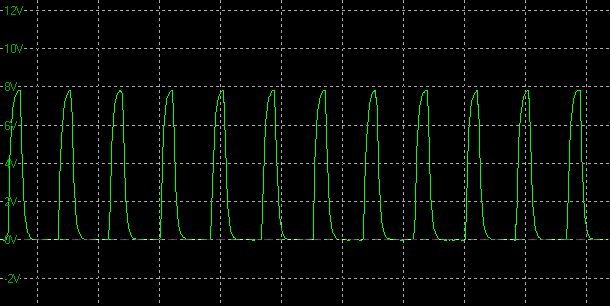
Extreme mode - Example strobing at 240Hz, horizontal scale = 5ms
The 'Extreme' VRB mode operates the same, except that the 'on' period is reduced down to 1.1ms (off period 3.07ms). In theory the shorter strobe is supposed to help improve motion clarity even further but at the cost of brightness. This mode was indeed noticeably darker than the 'normal' mode. We felt that in motion tests the moving content looked sharper and crisper, but at the same time this did accentuate the strobe cross talk a little and made that look sharper too. One to experiment with and it will be down to user preference as to how bright they want the screen we expect.
Max Brightness VRB (Normal mode)
|
Refresh Rate |
Luminance |
Black Point |
Contrast Ratio |
|
240Hz |
209.90 |
0.22 |
954:1 |
|
144Hz |
122.32 |
0.12 |
1019:1 |
Max Brightness VRB (Extreme mode)
|
Refresh Rate |
Luminance |
Black Point |
Contrast Ratio |
|
240Hz |
133.97 |
0.14 |
957:1 |
|
144Hz |
78.75 |
0.08 |
984:1 |
When you enable the VRB mode the brightness control becomes locked, and there is no way to manually control it yourself. It doesn't matter what your brightness control was before, the luminance output when you enable VRB is always the same. This does vary depending on the refresh rate, but oddly (and like the recently tested Acer Nitro XF252Q display) the brightness actually increases as you increase the refresh rate. You would think that with more strobes per second, the brightness would be negatively impacted, but here it is the increased 'off' time as refresh rate lowers that leads to the reduced overall brightness of the image. You can see that the 'Extreme' mode has a fairly noticeable impact on brightness of the screen. You will see from our motion clarity tests below that there wasn't really any major improvement when switching to the 'Extreme' mode, but you may want to use if to limit your brightness a bit potentially. For those who want a brighter VRB experience though, it was nice to see a high upper brightness capability from this display.
Maximum Blur Reduction Brightness - Display Comparison
For ease of reference we have also provided a comparison table below of all the blur reduction enabled displays we've tested, showing their maximum luminance before blur reduction is turned on (normal mode) and their maximum luminance with the feature enabled. This will give you an idea of the maximum brightness you can expect from each model when using their blur reduction feature, if that is important to you. A lot of people want a brighter display for gaming and sometimes the relatively low maximum luminance from blur reduction modes is a limitation.
These comparisons are with the refresh rate as high as is available for the blur reduction feature to function. For most this is at 100 - 144Hz. You can often achieve a slightly brighter display if you use the feature at compatible lower refresh rates since the strobes are less frequent, but it's not a significant amount. That can also introduce more visible flicker in some situations.
|
Model |
Refresh Rate |
Max
Normal Luminance |
Max
Luminance Blur Reduction On |
|
Acer Nitro XF252Q |
240Hz |
413 |
226 |
|
Acer Nitro XV273K |
144Hz |
503 |
195 |
|
Acer Nitro XV273 X |
240Hz |
462 |
210 |
|
Acer Predator XB270HU* |
100Hz* |
327 |
111 |
|
Acer Predator Z35 |
120Hz |
359 |
111 |
|
Asus ROG Strix XG35VQ |
100Hz |
376 |
164 |
|
Asus ROG Swift PG258Q |
144Hz |
488 |
275 |
|
Asus ROG Swift PG278Q |
120Hz |
385 |
123 |
|
Asus ROG Swift PG279Q |
120Hz |
331 |
101 |
|
BenQ XL2720Z |
144Hz |
282 |
119 |
|
BenQ XL2730Z |
120Hz |
309 |
191 |
|
Dell S2716DG |
120Hz |
328 |
118 |
|
Eizo FG2421 |
120Hz |
386 |
257 |
|
Eizo FS2735 |
144Hz |
331 |
180 |
|
Gigabyte Aorus AD27QD |
144Hz |
471 |
129 |
|
LG 27GK750F |
240Hz |
452 |
199 |
|
LG 34GK950F |
144Hz |
390 |
235 |
|
LG 34UC79G |
144Hz |
267 |
141 |
|
LG 38UC99 |
75Hz |
308 |
213 |
Note: Pulse Width setting at max where applicable.
*Note 2: The Acer XB270HU was later updated to include a 120Hz mode, which will
produce a slightly darker maximum luminance
Blur Reduction Tests
Of course the main thing we want to test is what improvements the Blur Reduction mode offers when it comes to motion clarity and gaming. The following pursuit camera photos give you an indication of observed motion clarity as the human eye would see it at the top, middle and bottom areas of the screen. These were captured at the maximum refresh rate. Note that with VRB turned off, the motion clarity was the same in all areas of the screen which is why we've only included one image for that state.
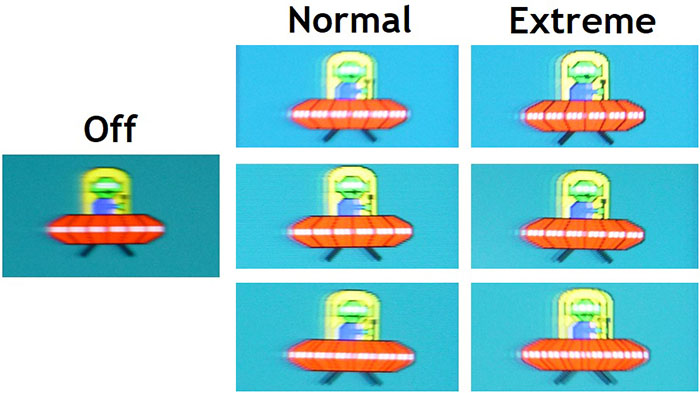
Pursuit camera photos capturing motion clarity in 'off' mode, then both the
'Normal' and 'Extreme' VRB settings
Shown at the top, middle and bottom areas of the screen (refresh rate = 240Hz)
As with most strobing blur reduction backlights it did help improve eye tracking of moving objects across the screen, making them sharper and easier to follow. That's one of the key benefits of this kind of technology. There was minimal strobe cross talk visible in the upper and middle regions of the screen, which is where you get a slight ghosting to the moving image. In the bottom area of the screen this was a bit more noticeable and it's impossible to eliminate this all together. The Extreme VRB mode sharpened the image up a little more at the cost of some brightness, but the trailing cross-talk did then look a little sharper and more noticeable too we felt. We were pleased though with the overall motion clarity and improvements in how easy it was to track moving objects with this mode enabled.
Overall we were impressed by the operation of the VRB mode on this display, it worked well. Given the very fast response times and high refresh rate, many people will find the non-VRB operation very fast as well, and so you might benefit more from the VRR support offered by using the FreeSync/G-sync mode instead of the VRB function.

Gaming Comparisons
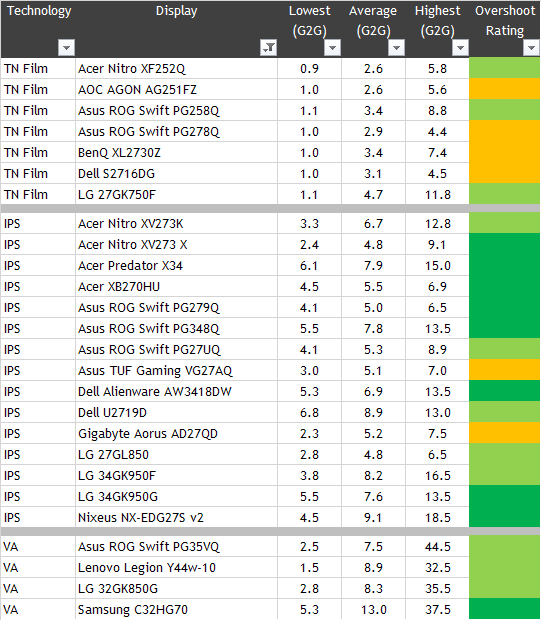
We have provided a comparison of the display against many other gaming screens we have reviewed in a similar size range and across a range of panel technologies. This table is now split by panel technology to make life a bit easier and for quicker comparison. The XV273 X was the fastest overall IPS panel we have measured to date which was excellent news. With a 4.8ms G2G average it matched the recently tested LG 27GL850 which had been really impressive in this area as well. That LG screen could "only" support up to 144Hz refresh rate and so there is a fairly decent jump here on the XV273 X when it comes to frame rate support (up to 240Hz) as well as some reasonable improvements in motion clarity as a result. At 240Hz the XV273 X was also completely free from any overshoot, whereas the LG 27GL850 showed a little on some transitions. A very impressive gaming performance from the XV273 X when you consider the high refresh rate, fast response times and absence of overshoot.
You can also compare the response times against the other 240Hz models we've tested, all with TN Film panels - the Acer Nitro XF252Q, AOC AGON AG251FZ and Asus ROG Swift PG25Q. They had slightly faster response times down to around 2.6 - 3.4ms which was better at keeping up with the frame rate demands. There was a little more overshoot introduced as a result, only minor on the Acer and Asus models, but up to moderate overshoot on the AOC.
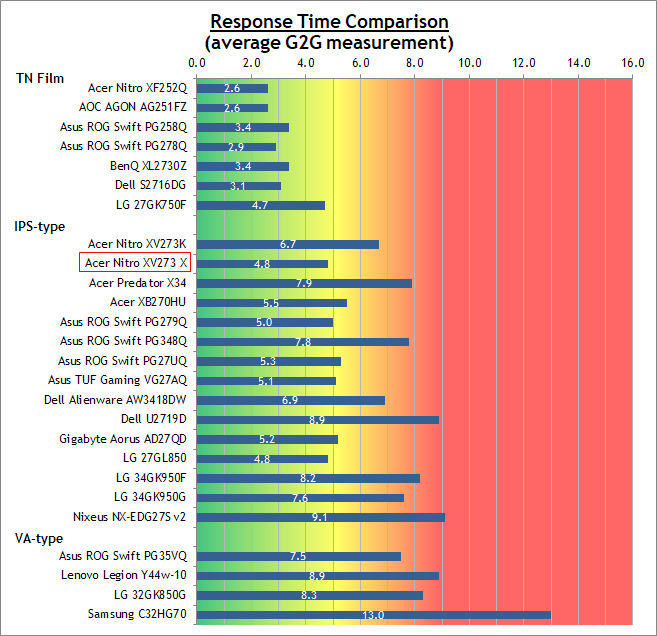

Additional
Gaming Features
-
Aspect Ratio Control - the screen has various settings for hardware level aspect ratio control. This includes options for full, aspect and 1:1 which are probably going to be the most useful. The screen is 16:9 natively so most external devices are going to be fine without needing scaling anyway.
-
Preset Modes - There are a few different preset modes aimed at gaming that can be customised and used if you want. This includes modes for action, racing and sports. You can save your own settings for each of these modes too which is handy.
-
Aim point and refresh rate number - there are settings in the OSD for a familiar aim point graphics to be added to the screen, or a counter for your active refresh rate.

Lag
Read our detailed article about input lag and the various measurement techniques which are used to evaluate this aspect of a display. The screens tested are split into two measurements which are based on our overall display lag tests and half the average G2G response time, as measured by our oscilloscope. The response time element, part of the lag you can see, is split from the overall display lag and shown on the graph as the green bar. From there, the signal processing (red bar) can be provided as a good estimation of the lag you would feel from the display. We also classify each display as follows:
Lag Classification
-
Class 1) Less than 8.33ms - the equivalent to 1 frame lag of a display at 120Hz refresh rate - should be fine for gamers, even at high levels
-
Class 2) A lag of 8.33 - 16.66ms - the equivalent of one to two frames at a 120Hz refresh rate - moderate lag but should be fine for many gamers. Caution advised for serious gaming
-
Class 3) A lag of more than 16.66ms - the equivalent of more than 2 frames at a refresh rate of 120Hz - Some noticeable lag in daily usage, not suitable for high end gaming

For the full reviews of the models compared here and the dates they were written (and when screens were approximately released to the market), please see our full reviews index.
|
|
At 240Hz the total lag measured was a very impressive 2.00 ms total. The pixel response times should account for pretty much all of that display lag, and so we can say that there appears to be no added signal processing lag on this screen. If there is, it's certainly a tiny amount and <0.5ms. We observed the same result at 144Hz and 60Hz in fact. A small additional lag of about 1ms was added when the VRB strobing backlight was enabled but that's still basically nothing. An impressive result from this display and making it suitable for fast and competitive gaming.

Movies and Video
The following summarises the screens performance for videos and movie viewing:
|
Category |
Display Specs / Measurements |
Comments |
|
Size |
27" widescreen |
Fairly typical for a desktop monitor nowadays and smaller than TV's by a lot |
|
Aspect Ratio |
16:9 |
Well suited to most common 16:9 aspect content and input devices |
|
Resolution |
1920 x 1080 |
Can support native 1080p content only, but not Ultra HD natively |
|
HDCP |
Yes |
Suitable for encrypted content |
|
Connectivity |
1x DisplayPort 1.2 and 2x HDMI 2.0 |
Useful additional 2x HDMI input for external Blu-ray players or games consoles. |
|
Cables |
DisplayPort and HDMI |
Both DisplayPort and HDMI provided which is useful |
|
Ergonomics |
Tilt, height. swivel and rotate |
Good range of adjustments suitable to positioning the screen in a variety of angles for different viewing positions. All pretty easy to move around. |
|
Coating |
Light Anti-glare |
Provides clear, non-grainy image and avoids unwanted reflections of full glossy solutions |
|
Brightness range |
90 - 462 cd/m2 |
Good adjustment range offered including a fairly high peak brightness only. Flicker free backlight operation with no PWM |
|
Contrast |
1036:1 after calibration |
Strong IPS contrast ratio which should be fine for most content. Buying an alternative VA technology panel would provide you a higher contrast ratio if you watch a lot of dark content and miss some shadow detail |
|
Preset modes |
None |
No specific movie or video preset mode, but you could easily set up one of the Game modes if you wanted. |
|
Response times |
4.8ms G2G, no overshoot at 240Hz (Normal mode) 5.2ms G2G at 60Hz with no overshoot (Off mode) |
Response times are excellent overall with no noticeable overshoot when using the optimal response time settings. For 60Hz inputs and external devices you may want to switch to the 'Off' mode if you spot any issues with overshoot in the 'Normal' mode, although they are very minimal anyway. Even at 60Hz the response times are decent. |
|
Viewing angles |
Very good |
Thanks to the IPS panel technology, suitable for viewing from a wide range of positions. IPS glow on dark content could present a problem from some wider angles especially in darker room conditions |
|
Backlight bleed |
No major bleed |
Some slight clouding most noticeable in the top left hand corner on our sample but nothing major |
|
Audio |
Headphone output and 2x 2W speakers |
Basic integrated speakers on this model which might be ok for the occasional YouTube clip or mp3 but not much more. A headphone jack is also provided |
|
Aspect Ratio Controls |
Full , Aspect and 1:1 modes |
Good options to account for non-16:9 format inputs via the "aspect" and "1:1" modes if needed although the native aspect of the screen is likely to be suitable for a lot of content |
|
PiP / PbP |
Neither supported |
n/a |

HDR (High Dynamic Range)
|
HDR Capability Summary |
HDR Technical Capabilities |
|||
|
VESA DisplayHDR Certification level |
HDR 400 |
|
Local Dimming |
No |
|
Certified to the rather meaningless HDR 400 standard which does not require any form of local dimming and so cannot offer improved dynamic range/contrast. There is also only a standard sRGB gamut and 8-bit colour depth so no additional colour benefits for HDR either. |
|
Increased dynamic range (contrast) |
n/a |
|
|
|
Increased peak brightness |
457 cd/m2 |
||
|
|
Wide DCI-P3 colour gamut |
No |
||
|
|
10-bit Colour Depth |
8-bit |
||
The screen can take an HDR input signal but has no local dimming capability, so cannot truly offer an improved dynamic range. It has a peak brightness of >400 cd/m2 so carries the rather meaningless HDR400 certification. When you input an HDR source (like activating HDR in Windows 10) you have to also switch to the HDR mode in the preset menu on the display. With the HDR mode activated you lose access to some of the OSD settings for brightness and colour controls, but things like the overdrive control remain available. We confirmed that the HDR mode could be used with adaptive-sync as well at the same time.
We activated HDR mode and measured a peak brightness of 457 cd/m2, which was no better than the 462 cd/m2 maximum we'd measured in SDR normal mode. The screen also lacks any other common HDR benefits as it has only a standard sRGB colour space and does not offer the extended DCI-P3 colour space and 10-bit colour depth that other HDR displays commonly offer. You can input an HDR source but just won't benefit from any improvements to the active contrast ratio of the image or the colour performance.

Conclusion
If you enjoy our work and want to say thanks, or would like to get early access to future reviews please consider becoming a TFT Central supporter.
This is the first 240Hz IPS monitor we've tested and it did not disappoint! It's the fastest overall IPS monitor we've tested to date, with excellent response times, no overshoot, no input lag, AMD and NVIDIA VRR support, 240fps/240Hz gaming, some additional motion clarity benefits compared with 144Hz, and even an added motion blur reduction mode if you want to use it. The screen offered a very impressive gaming performance we felt and it was very pleasing to see that the IPS technology could handle this next jump up in refresh rates. We'd rather manufacturers didn't push unrealistic response time specs as the advertised 1ms and certainly the 0.1ms were clearly fictitious. It's a very fast screen, but let's reign in the marketing folk a bit!
Sure, we would have loved it if the screen was a native 2560 x 1440 resolution, as the step down to 1080p was a bit of a hit when it came to general day to day uses. Right now, 1080p is your limit for 240Hz IPS gaming and is still a very popular option for gamers anyway. It's less of a drain on your system resources and graphics card as well so it will make achieving the upper 240Hz refresh rates more practical. If you're after a gaming screen primarily, we wouldn't let that 1080p resolution put you off and to many people it will actually be a positive.
Away from gaming the screen provided a decent setup and a wide range of options to play with. Contrast ratio was strong for an IPS panel and viewing angles were much wider than competing panel technologies, but being IPS it did suffer from the familiar IPS-glow on darker content. There's no real HDR benefits here at all despite the commonly used DisplayHDR 400 certification, so just be wary of that as well if HDR support is something you specifically want. The functionality of the stand and the available connection options were good and it was nice to see that corners were not cut there.
If you're after a very fast screen for gaming and want the
additional benefits that IPS can offer you over common TN Film models, this is
an excellent choice. 240Hz IPS is here!
|
Pros |
Cons |
|
Very fast response times, no overshoot, no lag, AMD and NVIDIA VRR support |
1080p resolution a step down for normal day to day uses compared with 1440p on a screen this size |
|
240Hz support for high refresh rate gaming, with some incremental motion clarity benefits compared with 144Hz |
No HDR benefits despite certification |
|
All-round benefits of IPS technology with wide viewing angles and great image quality |
Fairly typical IPS glow on darker content |
|
Check Pricing and Buy - Direct Links |
|
TFTCentral is a participant in the Amazon Services LLC Associates Programme, an affiliate advertising programme designed to provide a means for sites to earn advertising fees by advertising and linking to Amazon.com, Amazon.co.uk, Amazon.de, Amazon.ca and other Amazon stores worldwide. We also participate in a similar scheme for Overclockers.co.uk. |
|
TFT Central Awards Explained We have two award classifications as part of our reviews. There's the top 'Recommended' award, where a monitor is excellent and highly recommended by us. There is also an 'Approved' award for a very good screen which may not be perfect, but is still a very good display. These awards won't be given out every time, but look out for the logo at the bottom of the conclusion. A list of monitors which have won our awards is available here. |

